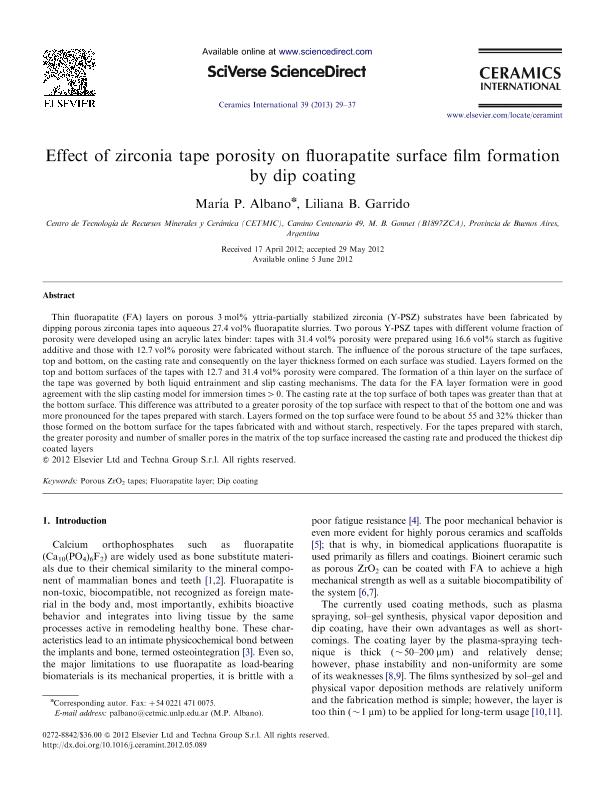Artículo
Effect of zirconia tape porosity on fluorapatite surface film formation by dip coating
Fecha de publicación:
01/2013
Editorial:
Elsevier
Revista:
Ceramics International
ISSN:
0272-8842
Idioma:
Inglés
Tipo de recurso:
Artículo publicado
Clasificación temática:
Resumen
Thin fluorapatite (FA) layers on porous 3 mol% yttria-partially stabilized zirconia (Y-PSZ) substrates have been fabricated by dipping porous zirconia tapes into aqueous 27.4 vol% fluorapatite slurries. Two porous Y-PSZ tapes with different volume fraction of porosity were developed using an acrylic latex binder: tapes with 31.4 vol% porosity were prepared using 16.6 vol% starch as fugitive additive and those with 12.7 vol% porosity were fabricated without starch. The influence of the porous structure of the tape surfaces, top and bottom, on the casting rate and consequently on the layer thickness formed on each surface was studied. Layers formed on the top and bottom surfaces of the tapes with 12.7 and 31.4 vol% porosity were compared. The formation of a thin layer on the surface of the tape was governed by both liquid entrainment and slip casting mechanisms. The data for the FA layer formation were in good agreement with the slip casting model for immersion times>0. The casting rate at the top surface of both tapes was greater than that at the bottom surface. This difference was attributed to a greater porosity of the top surface with respect to that of the bottom one and was more pronounced for the tapes prepared with starch. Layers formed on the top surface were found to be about 55 and 32% thicker than those formed on the bottom surface for the tapes fabricated with and without starch, respectively. For the tapes prepared with starch, the greater porosity and number of smaller pores in the matrix of the top surface increased the casting rate and produced the thickest dip coated layers.
Palabras clave:
Porous Zro2 Tapes
,
Fluorapatite Layer
,
Dip Coating
Archivos asociados
Licencia
Identificadores
Colecciones
Articulos(CETMIC)
Articulos de CENTRO TECNOL.DE REC.MINERALES Y CERAMICA (I)
Articulos de CENTRO TECNOL.DE REC.MINERALES Y CERAMICA (I)
Citación
Albano, Maria Patricia; Garrido, Liliana Beatriz; Effect of zirconia tape porosity on fluorapatite surface film formation by dip coating; Elsevier; Ceramics International; 39; 1; 1-2013; 29-37
Compartir
Altmétricas




